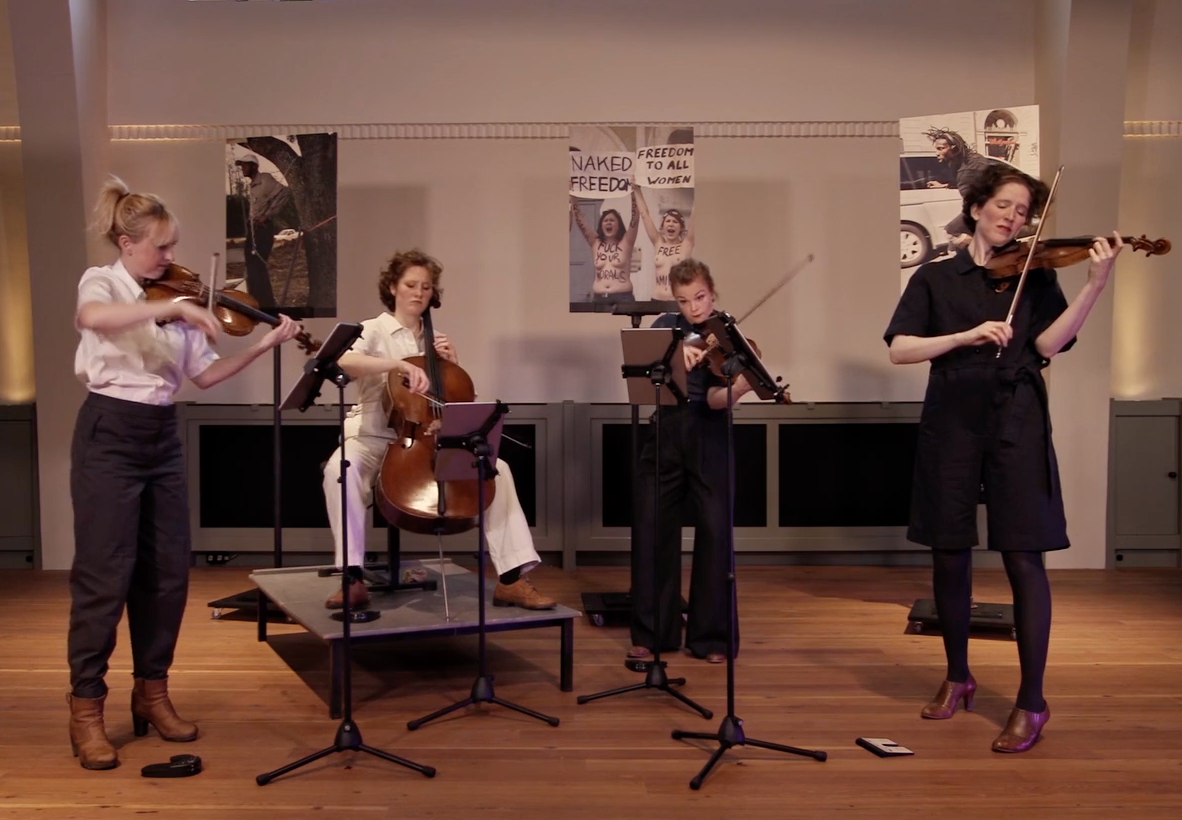
The Ragazze Quartet performing Garth Knox's 'Four Into Twenty'
Between Oppositions
As with many other festivals, in this year’s edition of the West Cork Chamber Music Festival – entitled ‘Bantry and Beyond’ – the emphasis is very much focused on the latter with only two of the festival’s thirty-one concerts actually coming from West Cork. Nevertheless, the organisers have wisely chosen to stretch out the festival’s offering over a period of two months resulting in a much more leisurely schedule than the live festival, which sometimes features up to six events in one day. This year’s concerts, which run until 25 July, include a broad selection of top Irish and international artists performing from venues across Europe and the United States.
Last Friday evening’s concert by the Dutch Ragazze Quartet (2 July) came from the Bethlehemkerk in Amsterdam and featured Bartók’s String Quartet No. 3, Korngold’s String Quartet No. 2 and a new quartet entitled Four Into Twenty by composer and violist Garth Knox. Although the theme of the concert was ‘The Roaring Twenties’, only one of the quartets, the Bartók, was actually composed in this decade. Korngold’s quartet was composed in 1933 and Knox’s new work came into being when the Ragazze Quartet approached him towards the end of 2019 and commissioned him to write a work that would make some sort of connection between the 1920s and the 2020s.
Writing in the programme note, Knox stated that he wanted to imagine ‘a musical work where qualities such as masculine, feminine, introvert, extrovert, passive, active, positive or negative can circulate without necessarily belonging definitely to one person.’ Constant movement between oppositions thus defined the piece.
Accommodating this diversity of material, Knox displayed an accomplished sense of form and a deep understanding of the timbral potential of the string quartet. The first movement furnished a good example of the former, beginning with a tightly wrought contrapuntal texture with all four players busily recycling chromatic fragments. This headlong motion eventually dissipated, the movement entering a section where an expressive melody on the second violin floated above muted recollections of the opening material. In the next section, the cello joined the first violin in an expressive duet while the second violin and viola bustled away in the background. By the end of the movement, all four instruments had coalesced into the same style having traversed the musical spectrum from agitated dissonance to a serene elegy.
The other characteristic of the quartet was its masterful string writing, something that one could have expected given Knox’s many years experience as an outstanding violist specialising in contemporary music. What stood out here though, was not the fact that he tried to pack in every extended technique in the book, but the sensitive ear for certain colours and sonorities using standard techniques. In the second movement, the violinists alternated a simple melodic fragment using harmonics and initiated by a single aggressive bow stroke. Against this, the viola and cello set up a whistling accompaniment figure using harmonics and glissandi. The combination produced a texture of delightful delicacy but just at the point when it seemed almost too fragile to touch, the music began to head off in a different direction as the downbeat coup d’archet became more forceful and the movement burst momentarily into what sounded like an Eastern European folk dance before dissolving away in a texture of upward glissandi.
The one unorthodox technique that stood out was the use of a ‘looping pizz’, a recent invention of Knox’s. The technique involves following up a pizzicato pluck with glissandi, utilising both hands so that it gives the impression of constantly rising but also staying near the same note. In the third movement, titled ‘Lockdown Blues’, this technique constituted the main cello riff which anchored a brittle texture of clashing dissonances and clockwork ticking – wonderfully capturing the melancholy inertia of recent times. After this, a brief folk-like solo for the first violinist livened things up before the piece concluded with a joyous reinterpretation of the Charleston dance and coming full circle with a coda that referenced the opening.
Sometimes we hear that a good premiere must leave a single indelible impression but with Knox’s quartet the only unifying element – apart from the ceaselessly inventive string writing – was its dizzying heterogeneity. Yet the more the listener embraced this diversity rather than resisting it, the greater the ultimate enjoyment of the piece, something that seemed to constitute a musical realisation of the political implications that Knox alluded to in his programme note.
Indeed politics were very much front and centre throughout the performance. Mobile scenery, featuring a series of photographs depicting images of protest and celebration and focusing on women and minorities, were part of the group’s effort to utilise the performance space. However well intentioned, this seemed to sit oddly within an all-male programme of white Europeans, Korngold’s Jewish heritage notwithstanding.
If the political dimension of the concert seemed a little half-baked, there was nothing unconvincing about the Ragazze Quartet’s playing and they flawlessly executed Knox’s quartet, approaching it with an exuberant energy and freshness after the challenging demands of the Bartók and Korngold’s quartets. In purely musical terms, the concert was very well programmed and the works sat well together with certain elements of the earlier quartet’s flashing through the prism of Knox’s contemporary imagination.
The West Cork Chamber Music Festival runs until 25 July. Visit https://ourconcerts.live/westcork.
Published on 8 July 2021
Adrian Smith is Lecturer in Musicology at TU Dublin Conservatoire.

















